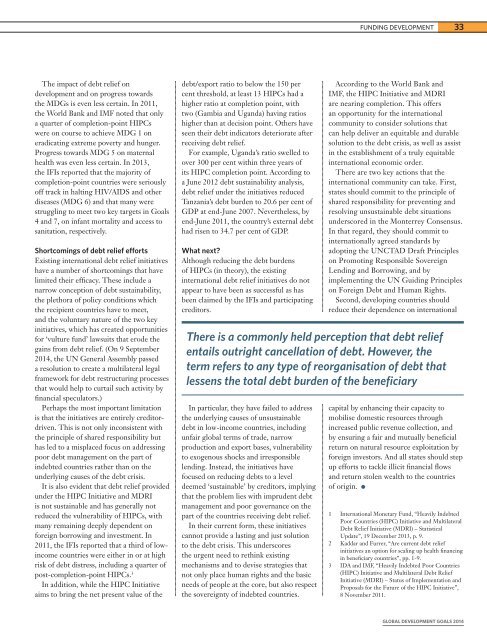FAMBB
FAMBB
FAMBB
You also want an ePaper? Increase the reach of your titles
YUMPU automatically turns print PDFs into web optimized ePapers that Google loves.
FUNDING DEVELOPMENT33The impact of debt relief ondevelopment and on progress towardsthe MDGs is even less certain. In 2011,the World Bank and IMF noted that onlya quarter of completion-point HIPCswere on course to achieve MDG 1 oneradicating extreme poverty and hunger.Progress towards MDG 5 on maternalhealth was even less certain. In 2013,the IFIs reported that the majority ofcompletion-point countries were seriouslyoff track in halting HIV/AIDS and otherdiseases (MDG 6) and that many werestruggling to meet two key targets in Goals4 and 7, on infant mortality and access tosanitation, respectively.Shortcomings of debt relief effortsExisting international debt relief initiativeshave a number of shortcomings that havelimited their efficacy. These include anarrow conception of debt sustainability,the plethora of policy conditions whichthe recipient countries have to meet,and the voluntary nature of the two keyinitiatives, which has created opportunitiesfor ‘vulture fund’ lawsuits that erode thegains from debt relief. (On 9 September2014, the UN General Assembly passeda resolution to create a multilateral legalframework for debt restructuring processesthat would help to curtail such activity byfinancial speculators.)Perhaps the most important limitationis that the initiatives are entirely creditordriven.This is not only inconsistent withthe principle of shared responsibility buthas led to a misplaced focus on addressingpoor debt management on the part ofindebted countries rather than on theunderlying causes of the debt crisis.It is also evident that debt relief providedunder the HIPC Initiative and MDRIis not sustainable and has generally notreduced the vulnerability of HIPCs, withmany remaining deeply dependent onforeign borrowing and investment. In2011, the IFIs reported that a third of lowincomecountries were either in or at highrisk of debt distress, including a quarter ofpost-completion-point HIPCs. 3In addition, while the HIPC Initiativeaims to bring the net present value of thedebt/export ratio to below the 150 percent threshold, at least 13 HIPCs had ahigher ratio at completion point, withtwo (Gambia and Uganda) having ratioshigher than at decision point. Others haveseen their debt indicators deteriorate afterreceiving debt relief.For example, Uganda’s ratio swelled toover 300 per cent within three years ofits HIPC completion point. According toa June 2012 debt sustainability analysis,debt relief under the initiatives reducedTanzania’s debt burden to 20.6 per cent ofGDP at end-June 2007. Nevertheless, byend-June 2011, the country’s external debthad risen to 34.7 per cent of GDP.What next?Although reducing the debt burdensof HIPCs (in theory), the existinginternational debt relief initiatives do notappear to have been as successful as hasbeen claimed by the IFIs and participatingcreditors.According to the World Bank andIMF, the HIPC Initiative and MDRIare nearing completion. This offersan opportunity for the internationalcommunity to consider solutions thatcan help deliver an equitable and durablesolution to the debt crisis, as well as assistin the establishment of a truly equitableinternational economic order.There are two key actions that theinternational community can take. First,states should commit to the principle ofshared responsibility for preventing andresolving unsustainable debt situationsunderscored in the Monterrey Consensus.In that regard, they should commit tointernationally agreed standards byadopting the UNCTAD Draft Principleson Promoting Responsible SovereignLending and Borrowing, and byimplementing the UN Guiding Principleson Foreign Debt and Human Rights.Second, developing countries shouldreduce their dependence on internationalThere is a commonly held perception that debt reliefentails outright cancellation of debt. However, theterm refers to any type of reorganisation of debt thatlessens the total debt burden of the beneficiaryIn particular, they have failed to addressthe underlying causes of unsustainabledebt in low-income countries, includingunfair global terms of trade, narrowproduction and export bases, vulnerabilityto exogenous shocks and irresponsiblelending. Instead, the initiatives havefocused on reducing debts to a leveldeemed ‘sustainable’ by creditors, implyingthat the problem lies with imprudent debtmanagement and poor governance on thepart of the countries receiving debt relief.In their current form, these initiativescannot provide a lasting and just solutionto the debt crisis. This underscoresthe urgent need to rethink existingmechanisms and to devise strategies thatnot only place human rights and the basicneeds of people at the core, but also respectthe sovereignty of indebted countries.capital by enhancing their capacity tomobilise domestic resources throughincreased public revenue collection, andby ensuring a fair and mutually beneficialreturn on natural resource exploitation byforeign investors. And all states should stepup efforts to tackle illicit financial flowsand return stolen wealth to the countriesof origin.1 International Monetary Fund, “Heavily IndebtedPoor Countries (HIPC) Initiative and MultilateralDebt Relief Initiative (MDRI) – StatisticalUpdate”, 19 December 2013, p. 9.2 Kaddar and Furrer, “Are current debt reliefinitiatives an option for scaling up health financingin beneficiary countries”, pp. 1-9.3 IDA and IMF, “Heavily Indebted Poor Countries(HIPC) Initiative and Multilateral Debt ReliefInitiative (MDRI) – Status of Implementation andProposals for the Future of the HIPC Initiative”,8 November 2011.GLOBAL DEVELOPMENT GOALS 2014


